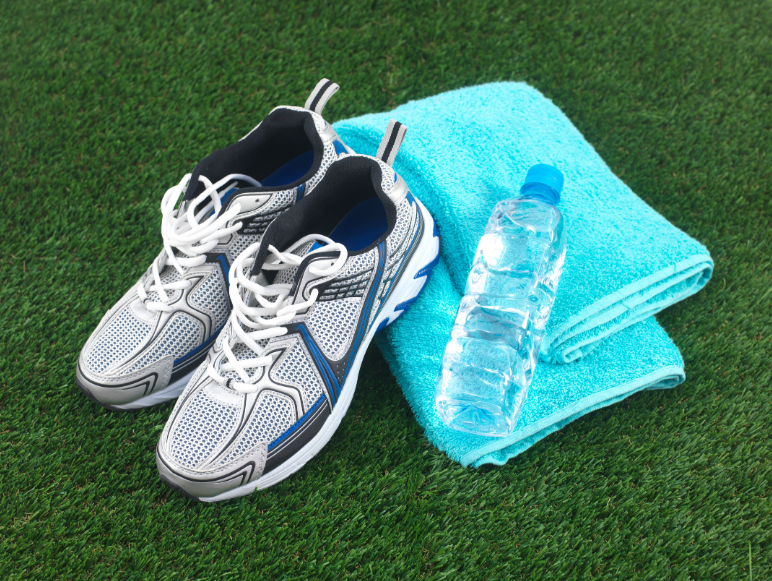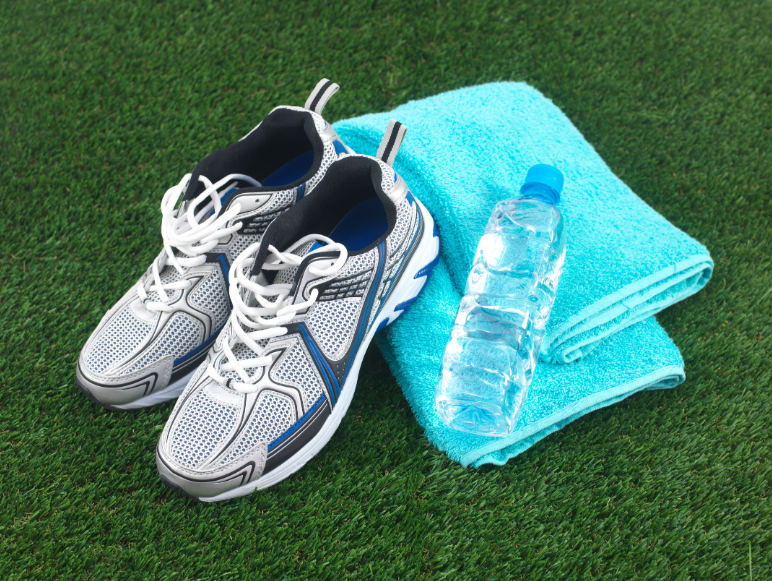By Kelly Jo Zellmann, MS, RDN, LD, CLT
Do you have a love-hate relationship with exercise? Or are you so rigid with your routines that missing one workout fills you with guilt? Do you exercise to burn calories or to feel good? Hopefully, you do it because it makes you feel good and that keeps you wanting to continue. However, for many people, years of dieting combined with strict exercise may have left them dreading the idea of working out. The good news is there are definitely some simple ways you can start increasing your movement and/or find new ways to stay motivated.
Our bodies were designed to move. Think of how active children are naturally. They want to be playing, running, jumping, and just moving. Sadly, in the era of cell phones, remote controls, and computers, adults have become more and more sedentary, which is a major health risk. The benefits of being active far outweigh the dangers of being more stationary or sitting. One study from the American Cancer Society found a link between long periods of sitting and a higher risk of death from all causes, including 14 of the 22 causes of death measured by the study. This included 8 of the 10 most common causes of death.
Benefits of movement: Physical activity has so many benefits! The list can go on, but here are just a few:
- Stress reduction
- Form of self-care
- Decreased bone strength
- Decreased blood pressure
- Improved cholesterol levels
- Increased metabolism
- Improved mood, decreased anxiety
- Improved memory and learning
- Prevents or slows cognitive decline associated with aging
- Reduces risk for chronic diseases such as heart disease, diabetes, hypertension (high blood pressure), stroke, and some types of cancers
How Much Movement Should We Aim for
The Center for Disease Control (CDC) and The American Cancer Society recommends that adults get at least 150 minutes of moderate-intensity aerobic activity (i.e. brisk walking) every week and 2 or more days a week of muscle-strengthening activities. Or 75 minutes of vigorous-intensity aerobic activity (jogging or running) every week and 2 or more days of muscle strengthening activities. That amounts to about 30 minutes/day, five days a week. It doesn’t have to be all at one time. Exercise can be broken up throughout your week to fit in when you can.
Focus on How it Feels, not on Numbers
What’s your why? Asking yourself why you do or don’t exercise can help figure out ways to address it. Many people focus on exercise as a means to lose weight (ie – how many calories burned or the number on the scale). However, this often results in a lack of motivation and is not sustainable (similar to diets) in the long run. Focusing on how your body feels before, during and after exercise is a much better motivator. This perspective can help make it just a normal part of your daily routine. Movement is an important ingredient to promote your overall health and wellness, increase quality of life and lower risk of disease. (Notice weight is not mentioned).
Four key areas can be used to assess how movement affects how you feel:
- How is your stress level? Are you better at handling stress after regular movement? Maybe this means you are less irritable and have a more laid back approach to situations.
- How is your energy level? Do you feel more energized or not? How do you feel after you exercise at different times of the day? Experimenting with this can help identify when your ideal exercise time is.
- How is your overall mood? Do you notice a change in your outlook? Do you feel more empowered and determined to get things done when you are more active?
- How is your sleep? Are you waking more refreshed and/or sleeping better?
Common Movement Mind Traps
According to Evelyn Tribole and Elyse Raish, authors of Intuitive Eating (2020), you may find yourself falling into one of these common mindset pitfalls:
“It’s not worth it.” Does exercise feel futile because you can’t meet a certain number of minutes or steps in a designated time? Just think if you added up all the 5-10 minute walk/movement breaks you could be doing and how they add up! Remember, every step and every minute counts! It doesn’t have to be all at once or reaching a certain goal every day or week. You are better off doing something versus nothing.
“I don’t have enough time.” Who has extra time in their schedule these days? Maybe you have had some extra down time during the pandemic, but that doesn’t mean exercise was first on your “to-do” list, right? There always seems to be more important and pressing things that end up taking up our time. Or maybe you are burning both ends of the candle just to get by these days, which results in not having extra time. Shifting your mindset to prioritizing movement as a form of daily self-care can help as you find creative ways to add movement into your daily routine. This could be little things like parking farther away in the parking lot to get extra steps in. If you are working long hours or multiple jobs, sneaking in extra steps during your breaks can all add up. Also, finding an accountability partner can also help. You aren’t as likely to hit snooze 5 times if you are meeting someone for an early morning walk, bike or run. This also makes movement more enjoyable by sharing it with someone else.
“I can’t afford a gym membership.” Guess what? I hate to burst your bubble, but exercise is absolutely free! You don’t need a gym membership, you don’t need special shoes or clothes. Movement is 100% free. The beauty of it is you can do it almost anywhere, anytime. You don’t even need much space (think jumping jacks in your living room or turning music on in the kitchen and dancing). There are so many ways to be more active without having to pay a dime.
Finding Motivation for Movement
You may need to get creative with finding ways to incorporate activity into your daily routine. A few things will help keep you motivated. First of all, choose activities you enjoy. Just like food and eating should be enjoyable, so should movement. If you don’t like it, how likely are you to keep up? Enjoyment is one of the main reasons any activity is sustainable. Ask yourself if you prefer doing things with other people and if so, find ways to be active together—either as a family or with friends. Change it up or challenge yourself by trying new activities. Maybe you’ve always wanted to try something new. YouTube has limitless options for yoga, dance, Tabata, etc. available at the click of your remote. Many communities have groups geared for starting a walking or running program. Or, if you get bored doing something (ie – stationary treadmill or machine), find a way to make it more interesting. Turn on a podcast, music or watch a TV show to help engage your mind with something else. There’s usually a fun way to help pass the time. Lastly, be sure you are comfortable. Wearing the right type of clothing can also make a difference. (Disclaimer: not an excuse to go on a total shopping spree, unless you can afford that.)
Remember to Rest (and Listen to your Body)
It is important to listen to your body and rest when needed. This is especially important if you are prone to injuries (from over-exercising) or pushing too hard. Your body will let you know what it needs. Don’t go too hard too fast so that you burn out. Moderation with movement is just as important as it is with eating.
Bottom line, mindful movement should be enjoyed. It should be something you look forward to and makes you feel good and crave more.
Curious for more information, check out the resources below and/or contact Kelly Jo Zellmann, MS, RDN, LD at kellyjo@nutritiousweighs.com.
References/Resources:
- The Center for Disease Control: https://www.cdc.gov/physicalactivity/basics/adults/index.htm
- Patel A, MAliniak M, Rees-Punia E, et al..Prolonged Leisure Time Spent Sitting in Relation to Cause-Specific Mortality in a Large US Cohort. Am J Epidemiol. 2018;187(10) 2151-2158
- Tribole, E., and E. Resch. (2020). Intuitive Eating. A Revolutionary Anti-Diet Approach. (4th edition). St. Martin’s Publishing.



